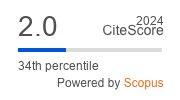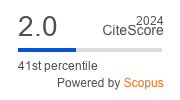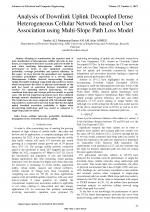| 2/2019 - 6 |
Analysis of Downlink Uplink Decoupled Dense Heterogeneous Cellular Network based on User Association using Multi-Slope Path Loss ModelALI, S. |
| Extra paper information in |
| Click to see author's profile in |
| Download PDF |
Author keywords
cellular networks, probability distribution, propagation losses, stochastic processes, uplink
References keywords
uplink(13), link(12), networks(11), communication(10), cellular(10), path(7), loss(7), communications(7), analysis(7), propagation(6)
Blue keywords are present in both the references section and the paper title.
About this article
Date of Publication: 2019-05-31
Volume 19, Issue 2, Year 2019, On page(s): 45 - 52
ISSN: 1582-7445, e-ISSN: 1844-7600
Digital Object Identifier: 10.4316/AECE.2019.02006
Web of Science Accession Number: 000475806300006
SCOPUS ID: 85066334149
Abstract
Keeping in consideration the expected need of node densification of heterogeneous cellular networks in near future, it is imperative that more accurate path loss models be used when analyzing heterogeneous cellular networks performance in terms of user equipment association probability, coverage probability and spectral efficiency. In this paper, we have derived the generalized user equipment association probabilities expressions of a two-tier Dense Heterogeneous Cellular Network incorporating Downlink Uplink Decoupled technique using multi-slope path loss model, which incorporates the effect of physical environment on the path loss based on separation between transmitter and receiver. For analyzing network performance, we have considered dual-slope and tri-slope path loss models as special cases. The derived analytical expressions have been validated through network simulations and found in good agreement. The results have also been compared with conventional single-slope path loss model and it has been found that the decoupled uplink downlink association probability is higher when incorporating multi-slope path loss model as compared to single-slope path loss model. |
| References | | | Cited By «-- Click to see who has cited this paper |
| [1] F. Jejdling, "Ericsson Mobility Report," Document ID: EAB-18:004510 Uen, June 2018.
[2] Cisco, "Cisco Visual Networking Index: Forecast and Trends,2017-2022," Document ID:1543280537836565, November 26, 2018 [3] J. Orlosky, K. Kiyokawa, H. Takemura, "Virtual and Augmented Reality on the 5G Highway," Journal of Information Processing, vol. 25, pp. 133-141, 2017. [CrossRef] [SCOPUS Times Cited 96] [4] K. Smiljkovikj, P. Popovski, L. Gavrilovska, "Analysis of the Decoupled Access for Downlink and Uplink in Wireless Heterogeneous Networks," IEEE Wireless Communication Letters, vol. 4, no. 2, pp. 173-176, 2015. [CrossRef] [SCOPUS Times Cited 106] [5] S. Singh, X. Zhang, J. G. Andrews, "Joint rate and SINR coverage analysis for decoupled uplink-downlink biased cell associations in HetNets," IEEE Transactions on Wireless Communication, vol. 14, no. 10, pp. 5360-5373, 2015. [CrossRef] [SCOPUS Times Cited 233] [6] M. N. Sial, J. Ahmed, "Analysis of K-tier 5G heterogeneous cellular network with dual-connectivity and uplink-downlink decoupled access," Journal on Telecommunication Systems, vol. 67, no. 4, pp. 669-685, 2018. [CrossRef] [SCOPUS Times Cited 19] [7] M. N. Sial, J. Ahmed, "A Realistic Uplink-Downlink Coupled and Decoupled User Association Technique for K-tier 5G HetNets," Arabian Journal for Science and Engineering, vol. 43, no. 6, pp 1-20, 2018. [CrossRef] [SCOPUS Times Cited 17] [8] M. Sial and J. Ahmed, A novel and realistic hybrid downlink-uplink coupled / decoupled access scheme for 5G HetNets. Turkish Journal on Electrical and Computer Engineering, vol. 25, no. 6, pp. 4457 - 4473, 2017. [CrossRef] [SCOPUS Times Cited 10] [9] F. Boccardi, J. Andrews, H. Elshaer, M. Dohler, S. Parkvall, P. Popovski, S. Singh, "Why to decouple the uplink and downlink in cellular networks and how to do it," IEEE Communication Magazine, vol. 54, no. 3, pp. 110-117, 2016. [CrossRef] [SCOPUS Times Cited 170] [10] J. G. Andrews, S. Buzzi, W. Choi, S. V. Hanly, A. Lozano, A. C. K. Soong, J. C. Zhang, "What Will 5G Be?," IEEE Journal on Selected Areas in Communications, vol. 32, no. 6, pp. 1065-1082, 2014. [CrossRef] [SCOPUS Times Cited 7271] [11] I. Chih-Lin, S. Han, Z. Xu, S. Wang, Q. Sun, Y. Chen, "New paradigm of 5G wireless internet," IEEE Journal on Selected Areas of Communication, vol. 34, no. 3, pp. 474-482, 2016. [CrossRef] [SCOPUS Times Cited 123] [12] M. Bacha, Y. Wu, B. Clerckx, "Downlink and uplink decoupling in two-tier heterogeneous networks with multi-antenna base stations," IEEE Transactions on Wireless Communication, vol. 16, no. 5, pp. 2760-2775, 2017. [CrossRef] [SCOPUS Times Cited 45] [13] L. Zhang, W. Nie, G. Feng, F.-C. Zheng, S. Qin, "Uplink performance improvement by decoupling uplink/downlink access in HetNets," IEEE Transactions on Vehicular Technology, vol. 66, no. 8, pp. 6862-6876, 2017. [CrossRef] [SCOPUS Times Cited 43] [14] H. Elshaer, M. N. Kulkarni, F. Boccardi, J. G. Andrews, M. Dohler, "Downlink and uplink cell association with traditional macrocells and millimeter wave small cells," IEEE Transactions on Wireless Communication, vol. 15, no. 9, pp. 6244-6258, 2016. [CrossRef] [SCOPUS Times Cited 187] [15] M. Di Renzo, P.Guan, "Stochastic geometry modeling and system-level analysis of uplink heterogeneous cellular networks with multi-antenna base stations," IEEE Transactions on Communication vol. 64, no. 6, pp. 2453-2476, 2016. [CrossRef] [SCOPUS Times Cited 74] [16] J. Park, S.-L. Kim, J. Zander, "Tractable resource management with uplink decoupled millimeter-wave overlay in ultra-dense cellular networks," IEEE Transactions on Wireless Communication, vol. 15, no. 6, pp. 4362-4379, 2016. [CrossRef] [SCOPUS Times Cited 88] [17] X. Sui, Z. Zhao, R. Li, H. Zhang, "Energy efficiency analysis of heterogeneous cellular networks with downlink and uplink decoupling," IEEE Global Communications Conference, pp. 1-7, 2015. [CrossRef] [18] H. H. Xia, "A simplified analytical model for predicting path loss in urban and suburban environments," IEEE Transactions on Vehicular Technology, vol. 46, no. 4, pp. 1040-1046, 1997. [CrossRef] [SCOPUS Times Cited 106] [19] V. Erceg, L. J. Greenstein, S. Y. Tjandra, S. R. Parkoff, A. Gupta, B. Kulic, A. A. Julius, R. Bianchi, "An empirically based path loss model for wireless channels in suburban environments," IEEE Journal on Selected Areas in Communications, vol. 17, no. 7, pp. 1205-1211, 1999. [CrossRef] [SCOPUS Times Cited 932] [20] T. K. Sarkar, J. Zhong, K. Kyungjung, A. Medouri, M. Salazar-Palma, "A survey of various propagation models for mobile communication," IEEE Antennas and Propagation Magazine, vol. 45, no. 3, pp. 51-82, 2003. [CrossRef] [SCOPUS Times Cited 769] [21] T. S. Rappaport, L. B. Milstein, "Effects of radio propagation path loss on DS-CDMA cellular frequency reuse efficiency for the reverse channel," IEEE Transactions on Vehicular Technology, vol. 41, no. 3, pp. 231-242, 1992. [CrossRef] [SCOPUS Times Cited 84] [22] H. Xia, H. L. Bertoni, L. R. Maciel, A. Lindsay-Stewart, R. Rowe, "Radio propagation characteristics for line-of-sight microcellular and personal communications," IEEE Transactions on Antennas and Propagation, vol. 41, no. 10, pp. 1439-1447, 1993. [CrossRef] [SCOPUS Times Cited 217] [23] V. Erceg, S. Ghassemzadeh, M. Taylor, D. Li, D. L. Schilling, "Urban/suburban out-of-sight propagation modeling," IEEE Communications Magazine, vol. 30, no. 6, pp. 56-61, 1992. [CrossRef] [SCOPUS Times Cited 93] [24] M. J. Feuerstein, K. L. Blackard, T. S. Rappaport, S. Y. Seidel, H. H. Xia, "Path loss, delay spread, and outage models as functions of antenna height for microcellular system design," IEEE Transactions on Vehicular Technology, vol. 43, no. 3, pp. 487-498, 1994. [CrossRef] [SCOPUS Times Cited 242] [25] A. K. Gupta, X. Zhang, J. G. Andrews, "SINR and Throughput Scaling in Ultradense Urban Cellular Networks," IEEE Wireless Communications Letters, vol. 4, no. 6, pp. 605-608, 2015. [CrossRef] [SCOPUS Times Cited 69] [26] X. Zhang, J. G.Andrews, "Downlink Cellular Network Analysis With Multi-Slope Path Loss Models," IEEE Transactions on Communication, vol. 63, no. 5, pp. 1881-1894, 2015. [CrossRef] [SCOPUS Times Cited 257] [27] V. M. Nguyen, M. Kountouris, "Coverage and capacity scaling laws in downlink ultra-dense cellular networks," IEEE International Conference on Communications, pp. 1-7, 2016. [CrossRef] [SCOPUS Times Cited 11] [28] A. A. Ammouri, J. G. Andrews, F. Baccelli, "A Unified Asymptotic Analysis of Area Spectral Efficiency in Ultradense Cellular Networks," IEEE Transactions on Information Theory, pp. 1-1, 2018. [CrossRef] [SCOPUS Times Cited 44] [29] B. Yang, G. Mao, M. Ding, X. Ge, X. Tao, "Dense Small Cell Networks: From Noise-Limited to Dense Interference-Limited," IEEE Transactions on Vehicular Technology, vol. 67, no. 5, pp. 4262-4277, 2018. [CrossRef] [SCOPUS Times Cited 60] [30] H. Munir, S. A. Hassan, H. Pervaiz, Q. Ni, L. Musavian, "Resource optimization in multi-tier HetNets exploiting multi-slope path loss model," IEEE Access vol. 5, pp. 8714-8726, 2017. [CrossRef] [SCOPUS Times Cited 25] [31] H. Munir, S. A. Hassan, H. Pervaiz, Q. Ni, L. Musavian, "User association in 5G heterogeneous networks exploiting multi-slope path loss model," Recent Trends in Telecommunications Research, pp. 1-5, 2017. [CrossRef] [SCOPUS Times Cited 13] Web of Science® Citations for all references: 0 SCOPUS® Citations for all references: 11,404 TCR Web of Science® Average Citations per reference: 0 SCOPUS® Average Citations per reference: 356 ACR TCR = Total Citations for References / ACR = Average Citations per Reference We introduced in 2010 - for the first time in scientific publishing, the term "References Weight", as a quantitative indication of the quality ... Read more Citations for references updated on 2025-07-03 00:51 in 197 seconds. Note1: Web of Science® is a registered trademark of Clarivate Analytics. Note2: SCOPUS® is a registered trademark of Elsevier B.V. Disclaimer: All queries to the respective databases were made by using the DOI record of every reference (where available). Due to technical problems beyond our control, the information is not always accurate. Please use the CrossRef link to visit the respective publisher site. |
Faculty of Electrical Engineering and Computer Science
Stefan cel Mare University of Suceava, Romania
All rights reserved: Advances in Electrical and Computer Engineering is a registered trademark of the Stefan cel Mare University of Suceava. No part of this publication may be reproduced, stored in a retrieval system, photocopied, recorded or archived, without the written permission from the Editor. When authors submit their papers for publication, they agree that the copyright for their article be transferred to the Faculty of Electrical Engineering and Computer Science, Stefan cel Mare University of Suceava, Romania, if and only if the articles are accepted for publication. The copyright covers the exclusive rights to reproduce and distribute the article, including reprints and translations.
Permission for other use: The copyright owner's consent does not extend to copying for general distribution, for promotion, for creating new works, or for resale. Specific written permission must be obtained from the Editor for such copying. Direct linking to files hosted on this website is strictly prohibited.
Disclaimer: Whilst every effort is made by the publishers and editorial board to see that no inaccurate or misleading data, opinions or statements appear in this journal, they wish to make it clear that all information and opinions formulated in the articles, as well as linguistic accuracy, are the sole responsibility of the author.



